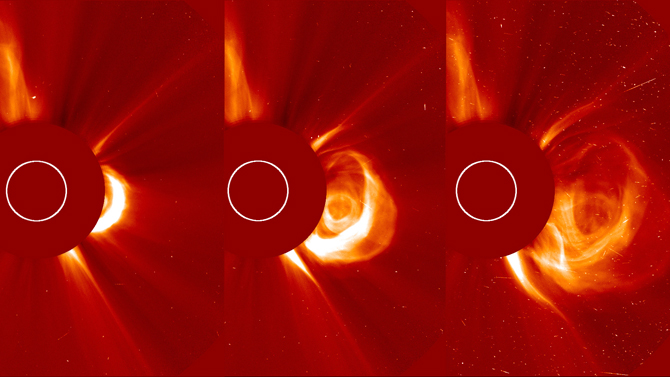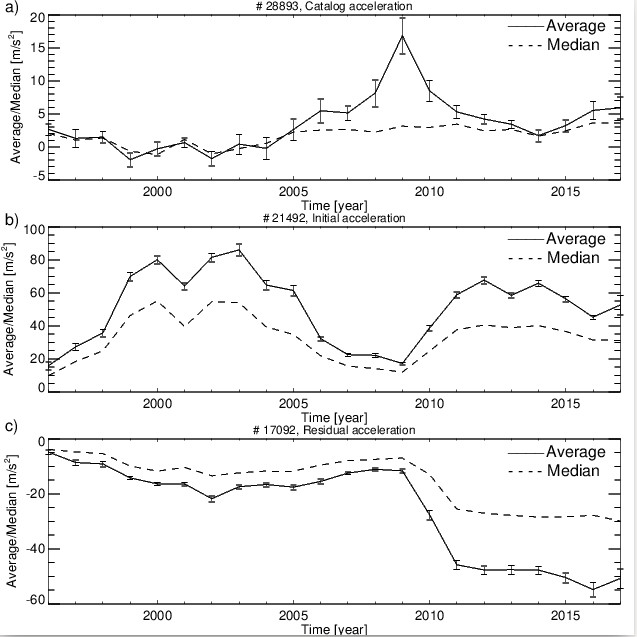Astronomy Object of the Month: 2021, July
< previous Archive next >
Kinematics of coronal mass ejections in the LASCO field of view
An accurate understanding of the propagation of coronal mass ejections
(CMEs) is crucial in the prediction of space weather. CMEs generate geomagnetic
storms causing catastrophic damages to power grids on Earth and are serious
radiation threat to satellites on low-Earth orbit and their crew during
spacewalks. Basic parameters such as their velocity and acceleration varying
with time and heliospheric distance away from the Sun gives researchers the
opportunity to predict their arrival time in the vicinity of the Earth. In this paper, we
analyze the trend of this parameter in regards to the solar cycles 23 and 24.

Illustration 1:
Evolution of a Coronal Mass Ejection seen by Large Angle and Spectrometric Coronagraphs (LASCO) on board SOlar and Heliospheric Observatory
(SOHO). A clear 3-part structure comprising (1) a bright front or leading edge;
(2) a dark cavity; and (3) a bright, compact core is visible.
Credit: NASA’s SOHO/LASCO.
Space weather is mostly
controlled by
coronal mass ejections (CMEs), which are huge expulsions of magnetized plasma from
the solar atmosphere. They have been intensively studied for their significant impact on
the Earth’s environment. The first CME was recorded by the coronograph on board the
7th
Orbiting Solar Observatory (OSO-7) satellite. Since 1995 CMEs have been intensively studied
using the sensitive Large Angle and Spectrometric Coronagraph (LASCO) instrument
on board the Solar and Heliospheric Observatory (SOHO) spacecraft. SOHO/LASCO
recorded about 30,000 CMEs until December 2017. The basic attributes of CMEs,
determined manually from LASCO images, are stored in the SOHO/LASCO catalog. The
initial velocity of CMEs, obtained by fitting a straight line to the height-time
data points, has been the basic parameter used in prediction of
geoeffectiveness of CMEs.
The two basic parameters, velocity and acceleration of CMEs, are obtained by fitting a straight and quadratic line to all the height-time data points measured for a given event. The parameters determined in this way, in some sense, reflect the average values in the field of view of the LASCO coronagraphs. Nevertheless, it is evident that both these parameters are continuously changing with distance and time after CME onset from the Sun. Therefore, the average values of velocity and acceleration, used in many studies, do not give a correct description of CME propagation. In this paper we present a statistical study of the kinematic properties of 28894 CMEs recorded by LASCO from 1996 to mid-2017. This research covers a large number of events observed during the 23 and 24 solar cycles. For the study, we employed SOHO/ LASCO catalog data and a new technique to determine the speed of ejections.
The presented statistical analysis reveals that at the beginning of their expansion, in the vicinity of the Sun, CMEs are subject to several factors (Lorentz Force, CME-CME interaction, speed differences between leading and trailing parts of the CME) that determine their propagation. Although their average values of catalog accelerations are always close to zero, a more detailed study shows that their instantaneous accelerations may be quite different depending on the conditions prevailing in the Sun and the environment in which they propagate. These conditions vary depending on the individual eruption and over time as the solar activity changes. The initial acceleration phase is characterized by a rapid increase in CME velocity just after eruption in the inner corona. This phase is followed by a non-significant residual acceleration (deceleration) characterized by an almost constant speed of CMEs. We demonstrate that the initial acceleration is in the range 0.24–2616 ms−2 with median (average) value of 57 ms−2 (ms−2) and it takes place up to a distance of about 28 RSUN with median (average) value of 7.8 RSUN (6 RSUN).
We note that the significant driving force of CME, namely Lorentz force, can operate up to a distance of 6 RSUN from the Sun during the first 2 hours of propagation. We found a significant anti-correlation between the initial acceleration magnitude and the acceleration duration, whereas the residual acceleration covers a range from −1224 to 0 m ms−2 with a median (average) value of −34 ms−2 (−17 ms−2). One intriguing finding is that the residual acceleration is much smaller during the 24 cycle in comparison to the 23 cycle of solar activity. Our study has also revealed that the considered parameters, initial acceleration (ACCINI), residual acceleration (ACCRES), maximum velocity (VMAX), and time at maximum velocity (TimeMAX) mostly follow solar cycles and the intensities of the individual cycle.

Illustration 2: Yearly median and average values of the
catalog (panel a), initial (panel b), and residual (panel c) acceleration vs time of the CMEs in the SOHO/LASCO catalog.
The error bars are standard errors on the average. Credit: The Authors.
Original publication: Kinematics of coronal mass ejections in the LASCO field of view, Ravishankar, A., Michałek, G., Yashiro, S., A&A, 639, A68, 2020.
The research was conducted at the Department of High Energy Astrophysics of the Jagiellonian University’s Astronomical Observatory (OAUJ). The work was supported by the Polish National Science Centre through the grant UMO-2017/25/B/ ST9/00536 and DSC grant N17/MNS/000038. This work was also supported by NASA LWS project led by Dr. N. Gopalswamy.
|
Grzegorz Michałek Astronomical Observatory Jagiellonian University G.Michalek [at] uj.edu.pl |
Anitha Ravishankar Postdoctoral Associate University of Calgary, Canada |


